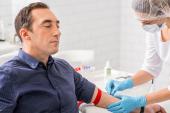ALPACA: Injectable siRNA Agent Safe and Effective for Lowering Lp(a)
With phase III trials ongoing, durable lepodisiran effects with no serious events are considered reassuring.

CHICAGO, IL—An investigational agent given by subcutaneous injection can drastically reduce levels of lipoprotein(a), with sustained effects seen out to about 1.5 years, according to data from the phase II ALPACA trial.
In patients with Lp(a) levels of at least 175 nmol/L, those who received the highest tested dose of lepodisiran (Eli Lilly) saw a 94% decline over 60 to 180 days compared with patients receiving placebo, meeting the endpoint for time-averaged percentage change. Safety with the extended-duration small interfering RNA (siRNA) agent was favorable, with few adverse events reported.
“Six decades after discovery of lipoprotein(a), finally advances in therapeutics have made possible the development of highly effective and durable therapies for reducing lipoprotein(a) serum concentrations,” said Steven E. Nissen, MD (Cleveland Clinic, OH), in a presentation here last week at the American College of Cardiology 2025 Scientific Session.
“Completion of ongoing phase III cardiovascular outcome trials is now a critical research priority to determine whether these therapies can reduce cardiovascular morbidity and mortality,” he added.
Numerous studies have pegged elevated Lp(a) as a genetic causal risk factor for atherosclerotic cardiovascular disease and aortic valve stenosis. While elevated levels are thought to be static, recent evidence suggests the numbers can fluctuate in some patients over a period of years.
A phase III trial of lepodisiran called ACCLAIM-Lp(a) is currently enrolling and other late-stage Lp(a)-lowering trials of two other agents also are underway: Lp(a)HORIZON is looking at the impact of the antisense medication pelacarsen (Ionis/Novartis) on major CV events in patients with elevated Lp(a); and OCEAN(a)-Outcomes is studying the impact of another siRNA, olpasiran (Amgen), on major CV events in patients with atherosclerotic cardiovascular disease and elevated Lp(a).
[W]e will allow these large outcome trials to tell the full story about both safety and efficacy. Steven E. Nissen
Eugenia Gianos, MD (Lenox Hill Hospital, Northwell Health, New York, NY), who commented on the results in the session, said the ALPACA data are helpful as physicians and patients await these ongoing outcomes trials in hopes they yield therapies to lower CV risk in those with elevated Lp(a).
However, given that low levels of Lp(a) have been associated with increased risk of intracranial hemorrhage and diabetes in observational data, she wondered if the ALPACA investigators have seen any hints of harm beyond elevations in liver function tests, and whether they plan to look at other biomarkers like HbA1c and high-sensitivity C-reactive protein in patients treated with lepodisiran.
In response, Nissen said he considers some of the observational data regarding the adverse impact of low Lp(a) to be not very solid. “[W]e will allow these large outcome trials to tell the full story about both safety and efficacy,” he said. “I’m personally very optimistic. There are 1.4 billion people on this planet that have elevated levels of lipoprotein(a), and there are 64 million in the United States. We’ve got to bring these studies forward.”
ALPACA Results
The ALPACA investigators enrolled 320 adults (mean age 62.7 years; 43% women) at 66 centers in 10 countries. The median baseline Lp(a) was 253.9 nmol/L, median LDL cholesterol level was 79.3 mg/dL, and median apolipoprotein B level was 79 mg/dL. Three-quarters of participants were also on statins, 33% on ezetimibe, and 6% on PCSK9 inhibitors.
Participants randomized to lepodisiran received 16 mg, 96 mg, or 400 mg at baseline and again at day 180, with one group receiving 400 mg at baseline and a placebo injection at day 180. The placebo group received placebo injections at both baseline and day 180.
Compared with the control arm, the pooled 400-mg groups had a 93.9% reduction in serum Lp(a) concentration from day 60 to day 180. The reduction was 40.8% and 75.2% with the 16-mg and 96-mg doses, respectively. Measures of serum apolipoprotein B also declined with lepodisiran, again with the greatest decreases from baseline being seen in the 400-mg groups.
Looking longer term at changes from day 30 to day 360, there was a 41.2% decrease in serum Lp(a) in the 16-mg group, 77.2% in the 96-mg group, 88.5% in the 400-mg plus placebo group, and 94.8% in the group that received 400 mg at baseline and day 180.
By day 540, the group that received 400 mg at baseline and at day 180 was down 197%, while the group that received 400 mg at baseline and placebo at day 180 was down 142%.
Of 236 participants with adverse events that emerged during treatment, 31 were deemed by investigators to have one related to lepodisiran or placebo. Discontinuation of treatment occurred in one placebo participant.
What Will the Future Hold?
Up to 12% of those who received lepodisiran had injection-site reactions. In the accompanying manuscript, which was simultaneously published in the New England Journal of Medicine, the ALPACA investigators describe these as “generally mild, transient, and dose-dependent.”
Regarding the liver enzyme elevations, 3% of lepodisiran patients had levels that increased to greater than three times the upper limit of normal without an increase in bilirubin level. In all cases, the investigators say these levels returned to baseline without intervention.
According to Nissen, the declines in serum Lp(a) were consistent across the cohorts, with just a few patients not experiencing large reductions.
Gianos said the 540-day data are “very reassuring” regarding the safety and efficacy of lepodisiran.
She wondered if there will be head-to-head trials of the various technologies being tested to lower Lp(a) since they are mechanistically different, and whether the availability of an oral agent will be important.
“The way I would look at this is that this is a soccer game. We have a number of shots on goal, and we’re hoping that at least one of them lands in the back of the net, and maybe they all will,” Nissen said. “There [are] certainly enough patients that need treatment. Having an oral agent will be important, and that must move forward. The different dosing intervals will offer some advantages and disadvantages. I’m just fine with the fact that we’ve got so many opportunities here to make a difference and I’m really hopeful that . . . maybe they will all work and that will be fantastic for patients.”
L.A. McKeown is a Senior Medical Journalist for TCTMD, the Section Editor of CV Team Forum, and Senior Medical…
Read Full BioSources
Nissen SE, Ni W, Shen X, et al. Lepodisiran—a long-duration small interfering RNA targeting lipoprotein(a). N Engl J Med. 2025;Epub ahead of print.
Disclosures
- The study was funded by Eli Lilly.
- Nissen reports research/research grants from AbbVie, Amgen, Arrowhead, AstraZeneca, Bristol Myers Squibb, Eli Lilly, Esperion Therapeutics, Medtronic, Mineralys, NewAmsterdam Pharma, Novartis, and Silence Therapeutics.





Comments